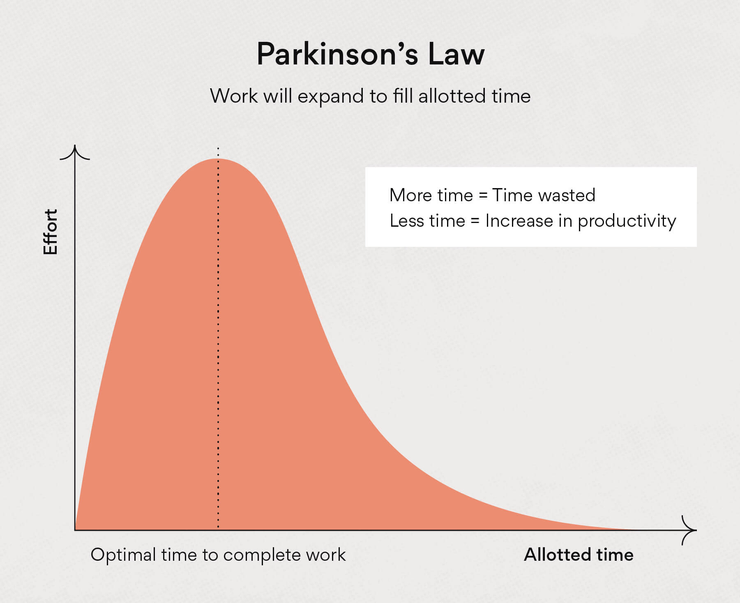PARKINSON’S LAW: An Incredibly Easy Method That Works For All
Work expands to fill the period available for its fulfillment. Parkinson’s Law insinuates that if it were an accurate observation, one would be able to assign a time limit of one minute to a task, and the task would become simple enough to complete within that minute.
What Is Parkinson's law?
Parkinson's law is the tendency for the amount of work required for something to increase so that it consumes any amount of time that may be allotted to it.
How To Turn How To Break The Imposter Syndrome Cycle! Into SuccessThe concept is often generalized to refer to the tendency for any available capacity in a given system to be used.
The implication is that no matter how extensive your resources are, the demands on them will grow to ensure they're depleted.
Parkinson's law has implications for many areas of business, including project management, time management, resource allocation, storage capacity planning, and requirements analysis.
Who introduced Parkinson’s Law?
Cyril Northcote Parkinson was a British naval historian who first introduced Parkinson’s Law in a satirical essay written for “The Economist” in 1955.
He then went on to write a book titled, Parkinson’s Law: The Pursuit of Progress. His story in the essay involves a woman whose sole task for the day is to send a postcard.
Because she has the entire day to complete this task, she spends an hour finding the card, half an hour finding her glasses, 90 minutes writing the card, and so forth until she fills her day.
His story is meant to explain how work expands to fill the time allotted. While Parkinson’s example may sound extreme, we’ve all experienced this on a smaller scale.
Studies suggest that when given a task, we think of how much time is available to complete the task instead of how much time we need. This mindset results in wasted time and inefficient workflows.
This is often why we, as humans, feel the need to take all the time we’re given to complete a task even if it doesn’t require that much time.
Few ways you can apply Parkinson’s Law to your life, get your to-do list checked off quicker, and spend less of the workday filling in time just to look busy.
Here Is A Method That Is Helping How You Can Trick Yourself Into Getting Stuff DoneThis is relevant whether you work in an office or at home, since “work harder, not smarter” is a cultural idea that many individuals fall prey to even when nobody’s supervising their work.
Source:asana.com
Get Better at Judging Time
At first, this will be partially an exercise in determining how accurate your time projections for tasks are.
Some may be spot on, to begin with, and some may be inflated if you’re not used to using Parkinson’s Law.
Those that are spot on maybe the ones that you are unable to beat the clock with when you halve the time allotment, so experiment with longer times. Don’t jump straight back to the original time allotment because there may be an optimum period in between.
If you work at a computer, a digital timer is going to be very useful when you start doing this. It’ll also save you a bit of time because a timer allows you to see at a glance how much longer you have. Using your clock involves some addition and subtraction!
Learn to Prioritize
These are tasks where 10% of what you do is important and 90% is useless when it comes to Parkinson’s Law.
This forces you to tend to the important tasks feed you need to read to improve your work (for instance, if you’re a web designer who needs to read up on new practices), and emails that are a high priority.
The More Time You Have The More Time You Waste.
The more time you have to work on a project, the more time it will take you to do it. You’ll procrastinate, “research,” explore divergent problems and opportunities, arbitrarily debate with yourself, and do anything other than what you’re supposed to be doing.
Procrastination is a powerful force. But there is hope. Read on for a few simple ways to improve your productivity and master your time.
Set. Deadlines.
The pressure of an imminent deadline is the ultimate fuel. When you’re up against the clock to complete something, your mind makes it happen.
Setting an aggressive deadline works because we are generally bad at knowing how long something will take to do. Once you start it, you have a much better idea.
How to overpower Parkinson’s Law
1. Plan your work strategically
When you strategically plan your work ahead of time, you’re less likely to procrastinate and more likely to work efficiently.
Creating a plan can help you manage your time, assess how long tasks will take, and plan them out accordingly.
In your plan, you should outline:
Your SMART goals
Your list of tasks and actions
The timeline for completion
The resources you’ll need
Specific dates you’ll check in on progress
2. Set self-imposed deadlines
The first step in overcoming Parkinson’s Law is to set self-imposed deadlines.
To figure out the time you need for a task, first:
Understand the project requirements: You’ll need a broad sense of what’s required of you to determine how long you’ll need for a project. This step involves creating a list of all the subtasks and activities within the larger project.
Prioritize activities and tasks accordingly: Once you have a list of your project requirements, you can prioritize your to-do list and determine which tasks are most important and/or complex. You should place the tasks that take the most time at the top of your list.
Decide who you need to involve: If parts of your project require help from coworkers, you’ll need to assess who to involve. Reaching out to your team at the beginning of your project can save you time later on.
Make your time estimates: You should now have a solid understanding of the who, what, and how involved in your upcoming project. You can now make realistic time estimates for completion based on your workload and your productivity level.
3. Try timeboxing
Timeboxing is a productive work strategy that can help you fight procrastination, recycle lost productivity, and focus on the work that matters.
Timeboxing involves setting a goal to finish a task within a certain time frame. When you plan how long a task should take before starting it, you become more intentional about your work.
You can use timeboxing to schedule personal tasks, help your team get organized, or manage meetings more effectively.
4. Try the Pomodoro Technique
An Introduction to The Pomodoro TechniqueThe five-step approach to managing your time with the Pomodoro Technique includes:
Create a list of tasks ordered by importance
Set a timer to 25 minutes
Work on a task for the duration of the timer
Take a five-minute break
After four pomodoros, take a 15-30 minute break
Overcoming Parkinson’s Law is essential if you want to take control of your time and increase the amount of work you’re able to complete. If you finish tasks before the deadline, you can use your extra time to get ahead on work or take a break. The goal is to be more efficient, not to overwork yourself.
You can experiment with Parkinson’s Law and squash your deadlines down to the bare minimum in many areas of your life.





Comments
Post a Comment